Experimental and Numerical Evaluation of Hydraulic Fracturing under High Temperature and Embedded Fractures in Large Concrete Samples
Abstract
1. Introduction
2. Initiation and Propagation Criterions of Hydraulic Fracture
2.1. Hydraulic Fracture Initiation Criterion
2.1.1. Stress Distribution Patterns around the Borehole
2.1.2. Hydraulic Fracture Initiation Pattern
2.1.3. Initiation Mode and Pressure
2.2. Propagation Criteria of Hydraulic Fracture
2.3. Mechanical Deformation of the Formation during Hydraulic Fracturing
2.4. Numerical Realization of Hydraulic Fracturing
3. Large-Scale Hydraulic Fracturing Experiments
3.1. Experimental System
3.2. Experimental Design and Sample Preparation
3.3. Hydraulic Fracturing Test Scheme
- (1)
- The hydraulic fracturing computer system was initialized.
- (2)
- The sample was loaded into the fracturing bin, and the counterforce device was installed.
- (3)
- The three confining pressures were adjusted to 10, 8, and 6 MPa.
- (4)
- After 5 min, the AE system was initialized.
- (5)
- Water (mixed with red ink) was injected, and the initial injection rate was kept constant at 5 mL/min.
- (6)
- The fracturing pressure curve was observed and shut in when the curve began to decrease from the peak value. The main purpose of this process was to monitor the initiation pressure.
- (7)
- Shut in about 5 min, and the fracturing test was re-started at an injection flow rate of 1 mL/min. The main purpose of this process was to monitor the extension action of the hydraulic fracture.
- (8)
- On the basis of the variation of the location of AE points, we knew how far the fracture had extended. When the AE event points extend to the sample boundaries, or there was a sudden drop in the injection pressure curve, or there was water flowing out of the fracturing bin, it was supposed that the hydraulic fracture had reached the sample boundaries. Then, the injection was stopped, the three confined pressures were released, and the sample was removed.
3.4. Fracturing Test Results and Discussions
3.4.1. Pressure Variations
3.4.2. Hydrofracture Morphology
3.4.3. AE Results of the Fracturing Tests
4. Comparison of the Numerical Simulation with the Laboratory Test
4.1. Model Settings
4.2. Numerical Simulation Results
5. Conclusions
- (1)
- The influence of high temperature on hydraulic fracturing showed the following features: many fractures were created, especially in the near-well region, and FP, EP, and fracture flow resistance became larger than that at room temperature. The reasons may be as follows. Sample brittleness decreased and plasticity increased with increasing temperature, which resulted in a high fracturing pressure. Moreover, the injected cold water (high temperature difference with the sample) generated many fractures because of thermal stress; numerous fractures led to large EP and flow resistance.
- (2)
- The 3D AE results of the fracturing process indicated that 3D stress and natural fractures significantly affected the extension direction of the hydraulic fracture. The spatial distribution pattern of natural fractures exerted a larger influence on the hydraulic fracture direction than that of triaxial stress. The fracturing pressure and EP of the sample decreased when natural fractures existed.
- (3)
- For hydraulic fracturing in the high temperature reservoir, a plastic zone was generated near the borehole, which increased as the injection pressure increased until the well wall reached failure. The hydraulic fracturing numerical simulation indicated that this hydraulic fracturing procedure can intuitively reflect the fracture geometry change during the propagation process.
Author Contributions
Funding
Conflicts of Interest
Nomenclature
| E | young’s modulus, MPa |
| G | shear modulus, MPa |
| T | permeability, m2 |
| KI | stress intensity factor, MPa·m0.5 |
| KIC | fracture toughness, MPa·m0.5 |
| ρ | density, kg/m3 |
| v | poisson’s ratio |
| n | porosity |
| σ | stress, MPa |
| σV | vertical stress, MPa |
| σH | maximum horizontal stress, MPa |
| σh | minimum horizontal stress, MPa |
| ε | strain |
| θ | angle |
| eb | elastic broken |
| pb | plastic broken |
| PF | pipe friction |
| FP | fracturing pressure |
| EP | extension pressure |
| FF | fracture friction |
References
- Lei, Z.H.; Zhang, Y.J.; Hu, Z.J.; Li, L.Z.; Zhang, S.Q.; Fu, L.; Yue, G.F. Application of Water Fracturing in Geothermal Energy Mining: Insights from Experimental Investigations. Energies 2019, 12, 2138. [Google Scholar] [CrossRef]
- Guo, L.L.; Zhang, Y.B.; Zhang, Y.J.; Yu, Z.W.; Zhang, J.N. Experimental investigation of granite properties under different temperatures and pressures and numerical analysis of damage effect in enhanced geothermal system. Renew. Energy 2018, 126, 107–125. [Google Scholar] [CrossRef]
- Tester, J.W.; Livesay, B.; Anderson, B.J.; Moore, M.C.; Bathchelor, A.S.; Nichols, K. The Future of Geothermal Energy: Impact of Enhanced Geothermal Systems (EGS) on the United States in the 21st Century; An Assessment by an MIT-Led Interdisciplinary Panel; MIT Press: Cambridge, MA, USA, 2006. [Google Scholar]
- Zeng, Y.C.; Su, Z.; Wu, N.Y. Numerical simulation of heat production potential from hot dry rock by water circulating through two horizontal wells at Desert Peak geothermal field. Energy 2013, 56, 92–107. [Google Scholar] [CrossRef]
- Arnorsson, S.; Axelsson, G.; Saemundsson, K. Geothermal systems in Iceland. Jokull 2007, 58, 269–302. [Google Scholar]
- Reinsch, T.; Dobson, P.; Asanuma, H.; Huenges, E.; Poletto, F.; Sanjuan, B. Utilizing supercritical geothermal systems: A review of past ventures and ongoing research activities. Geotherm. Energy 2017, 5, 16. [Google Scholar] [CrossRef]
- Quosay, A.A.; Knez, D.; Ziaja, J. Hydraulic fracturing: New uncertainty based modeling approach for process design using Monte Carlo simulation technique. PLoS ONE 2020, 15, e0236726. [Google Scholar] [CrossRef] [PubMed]
- Quosay, A.A.; Knez, D. Sensitivity Analysis on Fracturing Pressure Using Monte Carlo Simulation Technique. Oil Gas Eur. Mag. 2016, 42, 140–144. [Google Scholar]
- Parvizi, H.; Gomari, S.R.; Nabhani, F.N.; Monfared, A.D. Modeling the Risk of Commercial Failure for Hydraulic Fracturing Projects Due to Reservoir Heterogeneity. Energies 2018, 11, 218. [Google Scholar] [CrossRef]
- Basnet, C.B.; Panthi, K.K. Evaluation on the Minimum Principal Stress State and Potential Hydraulic Jacking from the Shotcrete-Lined Pressure Tunnel: A Case from Nepal. Rock Mech. Rock Eng. 2019, 52, 2377–2399. [Google Scholar] [CrossRef]
- Huang, J.; Fu, P.; Settgast, R.R.; Morris, J.P.; Ryerson, F.J. Evaluating a Simple Fracturing Criterion for a Hydraulic Fracture Crossing Stress and Stiffness Contrasts. Rock Mech. Rock Eng. 2019, 52, 1657–1670. [Google Scholar] [CrossRef]
- Jia, L.C.; Chen, M.; Sun, L.T.; Sun, Z.Y.; Zhang, W.; Zhu, Q.Q. Experimental study on propagation of hydraulic fracture in volcanic rocks using industrial CT technology. Pet. Explor. Dev. 2013, 40, 405–408. [Google Scholar] [CrossRef]
- Bouteca, M.J. 3D Analytical Model for Hydraulic Fracturing: Theory and Field Test; SPE-13276-MS; SPE: Richardson, TX, USA, 1984. [Google Scholar]
- Thiercelin, M.; Naceur, K.B.; Lemanczyk, Z.R. Simulation of Three-Dimensional Propagation of a Vertical Hydraulic Fracture; SPE-13861-MS; SPE: Richardson, TX, USA, 1985. [Google Scholar]
- Luis, A. Large Scale Hydraulic Fracturing Test on a Rock with Artificial Discontinuities. Ph.D. Thesis, Colorado School of Mines, Golden, CO, USA, 2007. [Google Scholar]
- Bauer, S.; Huang, K.; Chen, Q.; Ghassemi, A.; Barrow, P. Laboratory and numerical evaluation of EGS shear stimulation. In Proceedings of the 41st Workshop on Geothermal Reservoir Engineering, Stanford, CA, USA, 22–24 February 2016. SGP-TR-209. [Google Scholar]
- Anderson, G.D. Effects of friction on hydraulic fracture growth near unbonded interfaces in rocks. Soc. Pet. Eng. J. 1981, 21, 21–29. [Google Scholar] [CrossRef]
- Teufel, L.W.; Clark, J.A. Hydraulic fracture propagation in layered rock experimental studies of fracture containment. Soc. Pet. Eng. J. 1984, 24, 449–456. [Google Scholar] [CrossRef]
- Warpinski, N.R.; Clark, J.A.; Schmidt, R.A.; Huddle, C.W. Laboratory investigation on the effect of in-situ stress on hydraulic fracture containment. Soc. Pet. Eng. J. 1982, 22, 55–66. [Google Scholar] [CrossRef]
- Papadopoulos, J.M.; Narendran, V.M.; Cleary, M.P. Laboratory simulation of hydraulic fracturing. In Proceedings of the SPE/DOE Low Permeability Gas Reservoirs Symposium, Denver, CO, USA, 14–16 March 1983. SPE/DOE11618. [Google Scholar]
- Daneshy, A.A. Hydraulic fracture propagation in the presence of planes of weakness. In Proceedings of the SPE European Spring Meeting, Amsterdam, The Netherlands, 29–30 May 1974. SPE4852. [Google Scholar]
- Pater, C.J.; Beugelsdijk, L.J.L. Experiments and numerical simulation of hydraulic fracturing in naturally fractured rock. In Proceedings of the US Rock Mechanics Symposium, Anchorage, AK, USA, 25–29 June 2005. [Google Scholar]
- Zhou, H.W.; Xie, H.P.; Zuo, J.P. Developments in researches on mechanical behaviors of rocks under the condition of high ground pressure in the depths. Adv. Mech. 2005, 35, 91–99. [Google Scholar]
- Siratovich, P.; Heap, M.; Villeneuve, M.; Cole, J.; Kennedy, B.; Davidson, J.; Reuschlé, T. Mechanical behaviour of the Rotokawa Andesites (New Zealand): Insight into permeability evolution and stress-induced behaviour in an actively utilised geothermal reservoir. Geothermics 2016, 64, 163–179. [Google Scholar] [CrossRef]
- Guo, J.C.; He, S.G.; Deng, Y. Study of hydraulic fracturing initiation mode and initiation pressure of elastoplastic formation. Rock Soil Mech. 2015, 36, 2494–2500. [Google Scholar]
- Hossain, M.M.; Rahman, M.K.; Rahman, S.S. Hydraulic fracture initiation and propagation: Roles of wellbore trajectory, perforation and stress regimes. J. Pet. Sci. Eng. 2000, 27, 129–149. [Google Scholar] [CrossRef]
- Gao, H.; Zheng, Y.R.; Feng, X.T. Exploration on yield and failure of materials. J. Rock Mech. Eng. 2006, 25, 2515–2522. [Google Scholar]
- Shao, S.J.; Xu, P.; Chen, C.L. Several shear spatially mobilized planes and anisotropic strength criteria of soils. J. Geotech. Eng. 2013, 35, 422–435. [Google Scholar]
- Adachi, J.; Siebrits, E.; Peirce, A.; Desroches, J. Computer simulation of hydraulic fractures. Int. J. Rock Mech. Min. Sci. 2007, 44, 739–757. [Google Scholar] [CrossRef]
- StimPlan™/InjecPlan™ Version 6.00 [Computer Software]; NSI Technologies: Tulsa, OK, USA, 2015.
- F LAC3D Manual, Version 4.0; Itasca: Minneapolis, MN, USA, 2008.
- Zhou, L.; Hou, M.Z. A new numerical 3D-model for simulation of hydraulic fracturing in consideration of hydro-mechanical coupling effects. Int. J. Rock Mech. Min. Sci. 2013, 60, 370–380. [Google Scholar] [CrossRef]
- Zimmerman, R.W.; Kumar, S.; Bodvarsson, G.S. Lubrication theory analysis of the permeability of rough-walled fractures. Int. J. Rock Mech. Min. Sci. 1991, 28, 325–331. [Google Scholar] [CrossRef]
- Baria, R.; Baumgärtner, J.; Gérard, A.; Jung, R.; Garnish, J. European HDR research programme at Soultz-sous-Forets (France) 1987–1996. Geothermics 1999, 28, 655–669. [Google Scholar] [CrossRef]
- Chabora, E.; Zemach, E.; Spielman, P.; Drakos, P.; Hickman, S.; Lutz, S. Hydraulic stimulation of well 27-15, desert peak geothermal field, Nevada, USA. In Proceedings of the Thirty-Seventh Workshop on Geothermal Reservoir Engineering, Stanford, CA, USA, 30 January–1 February 2012. SGP-TR-194. [Google Scholar]
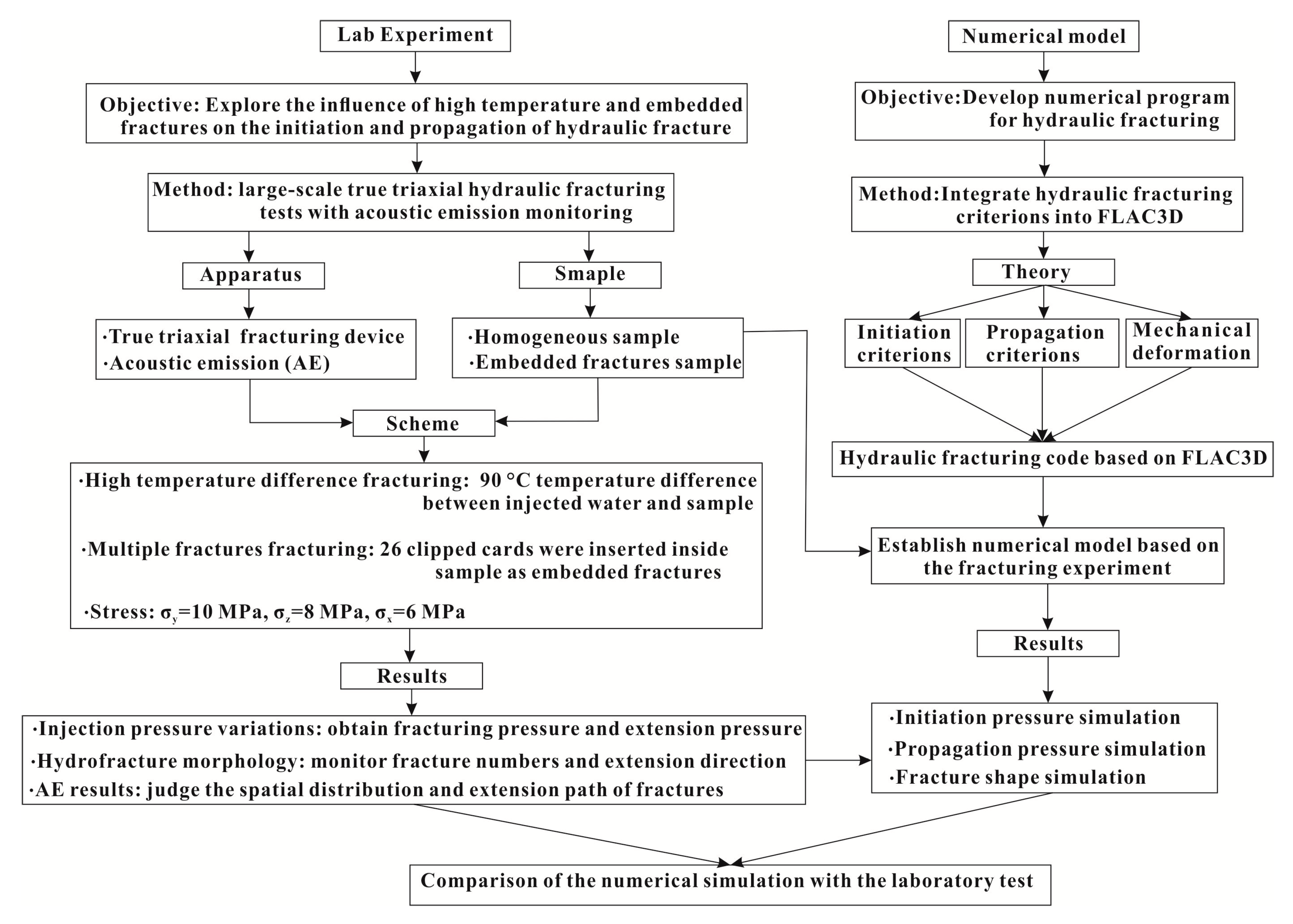
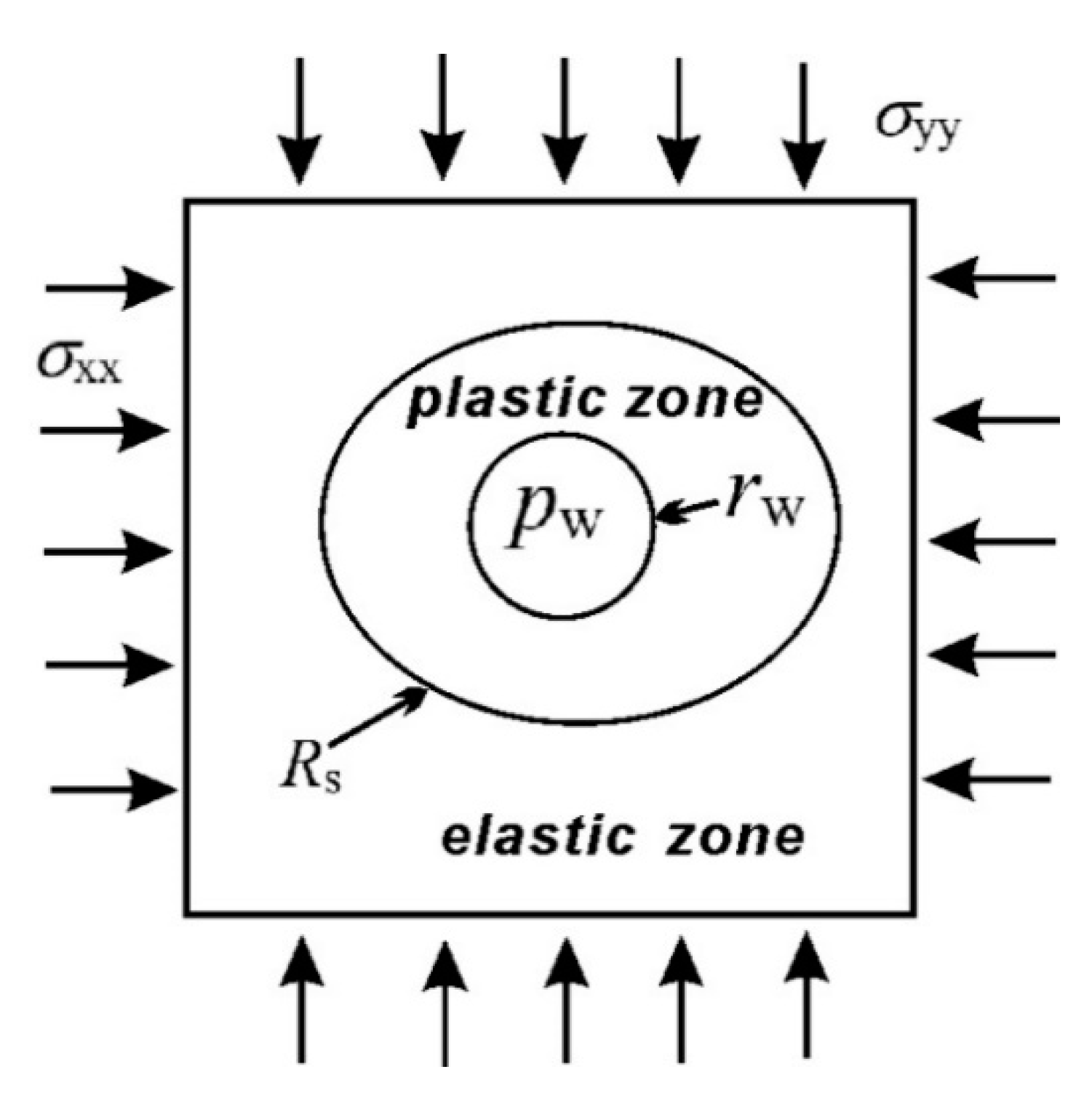
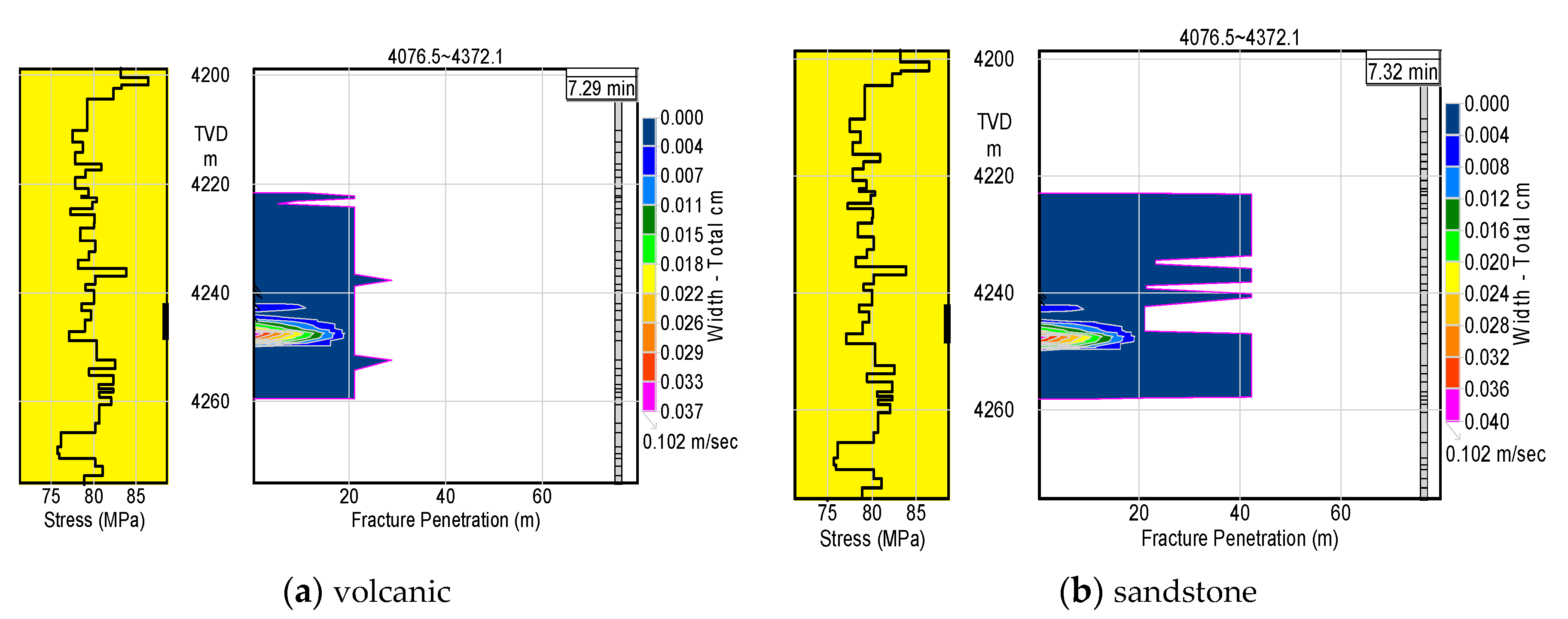

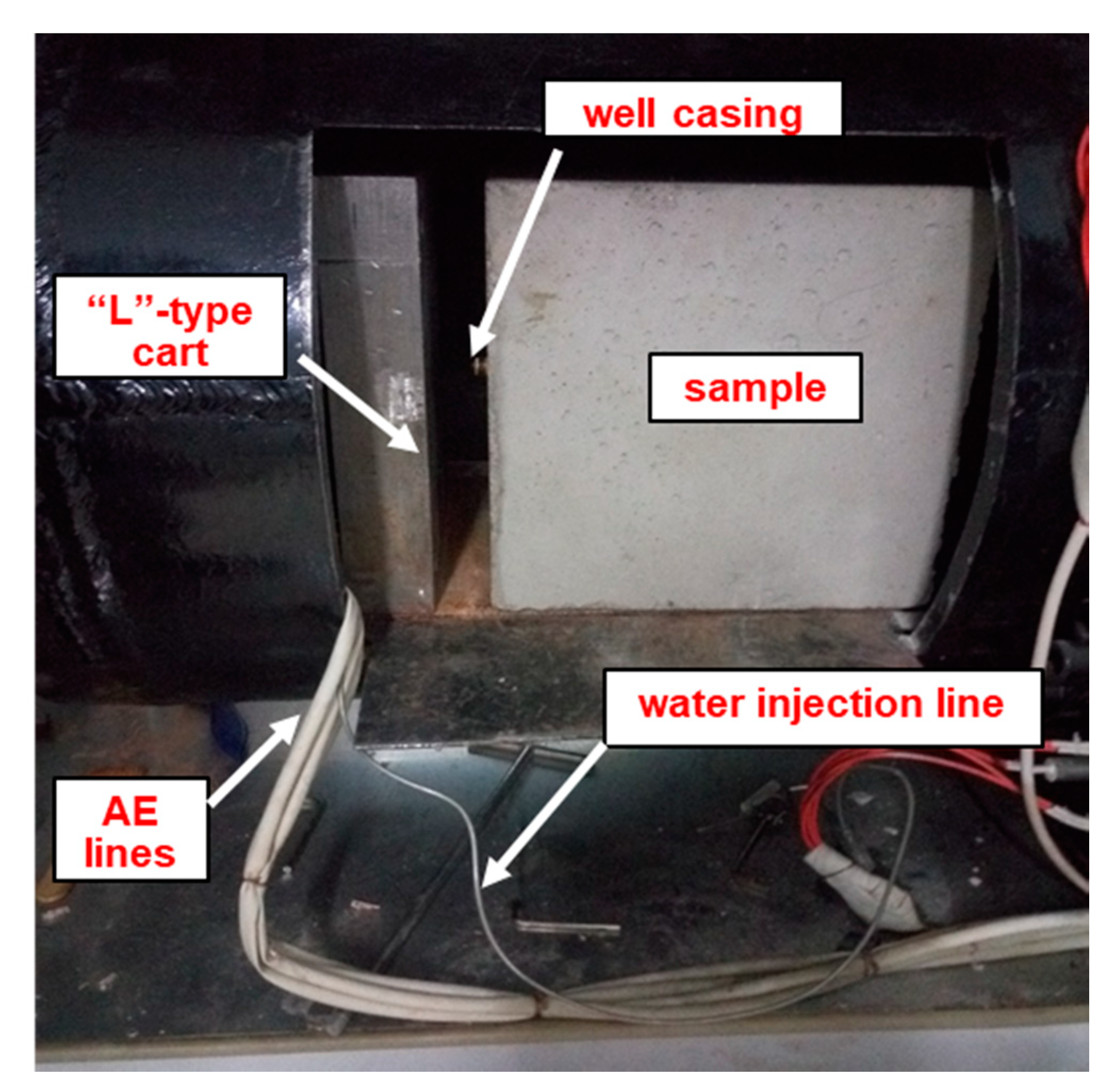
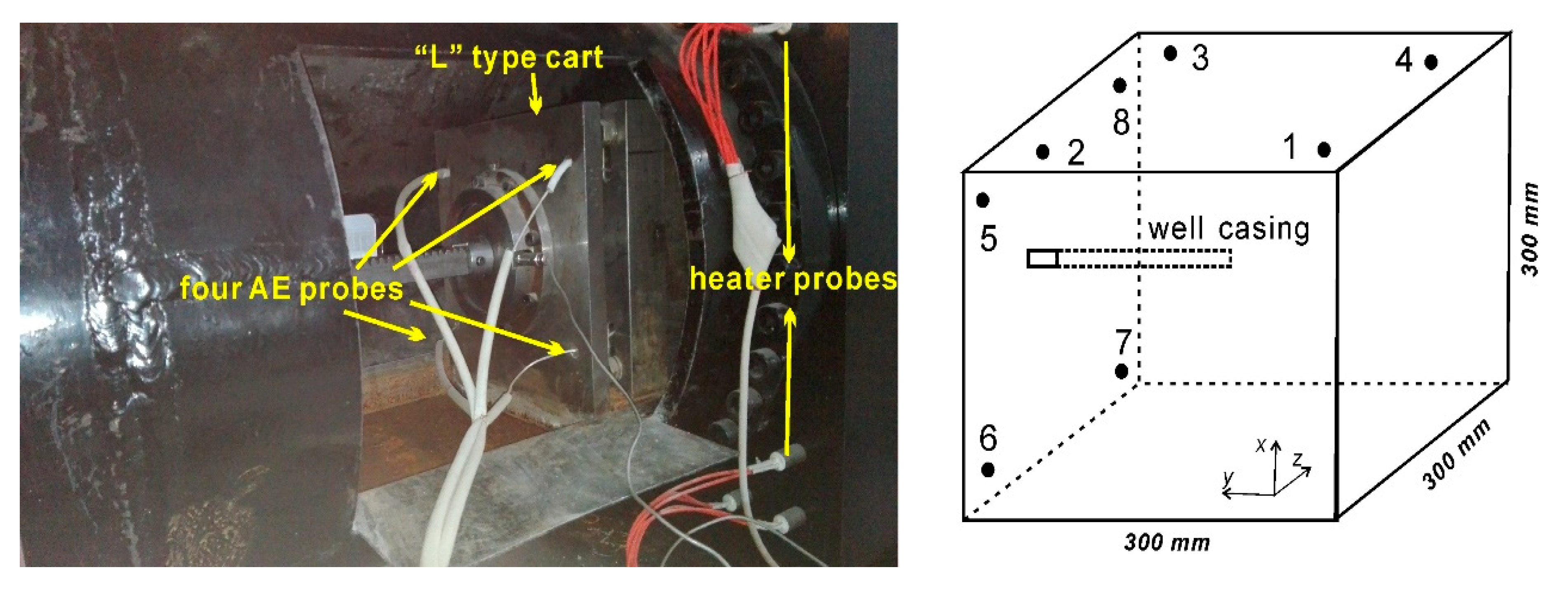
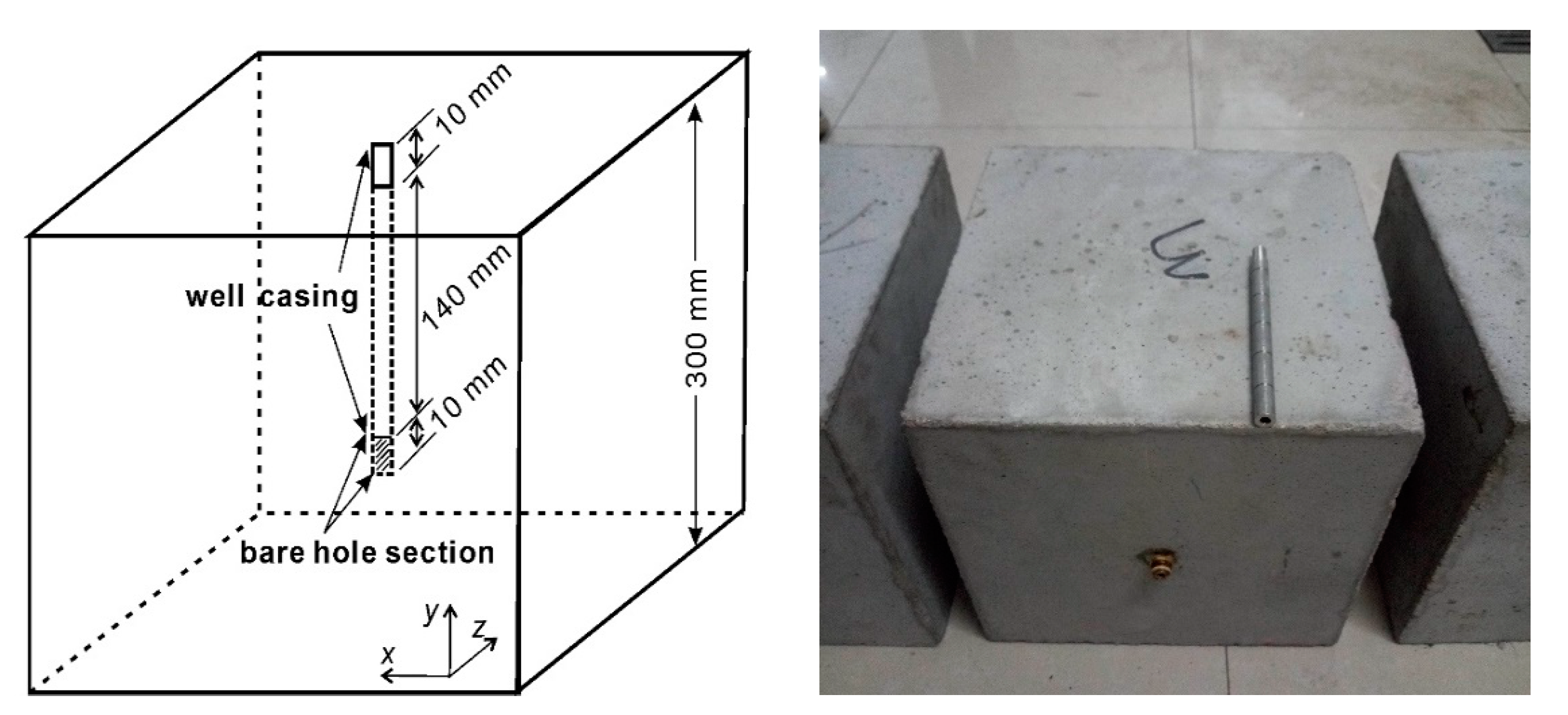


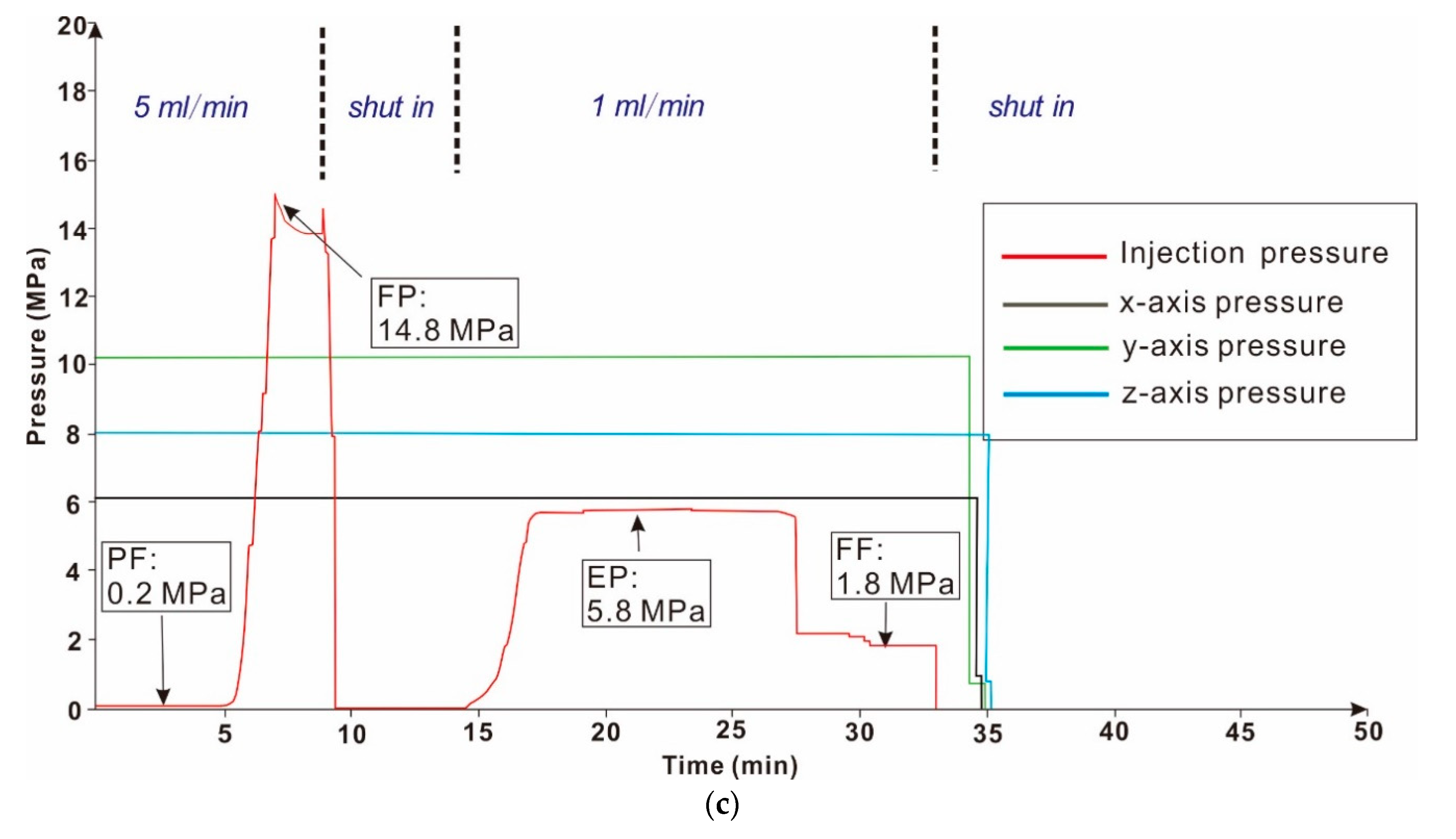
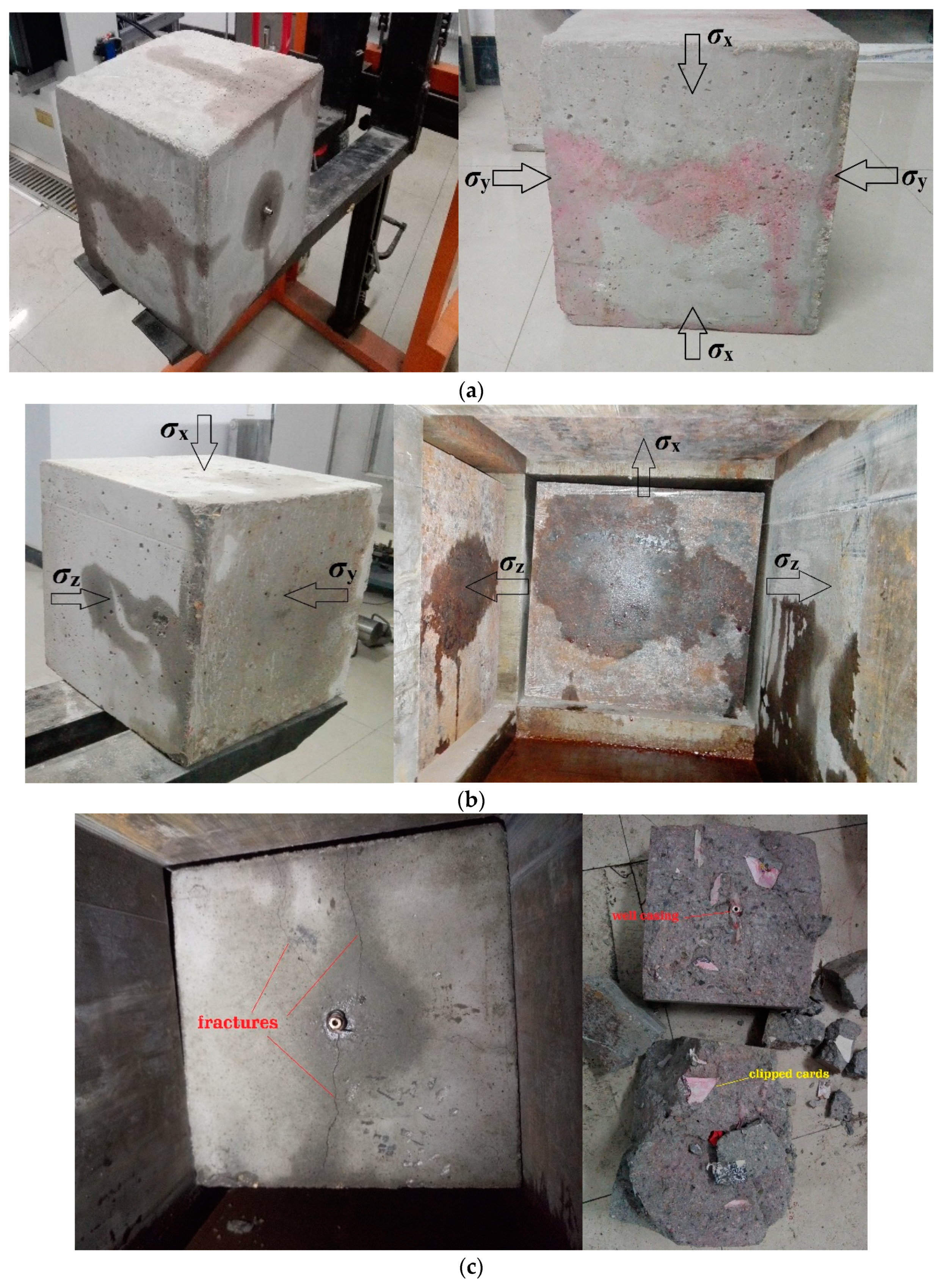
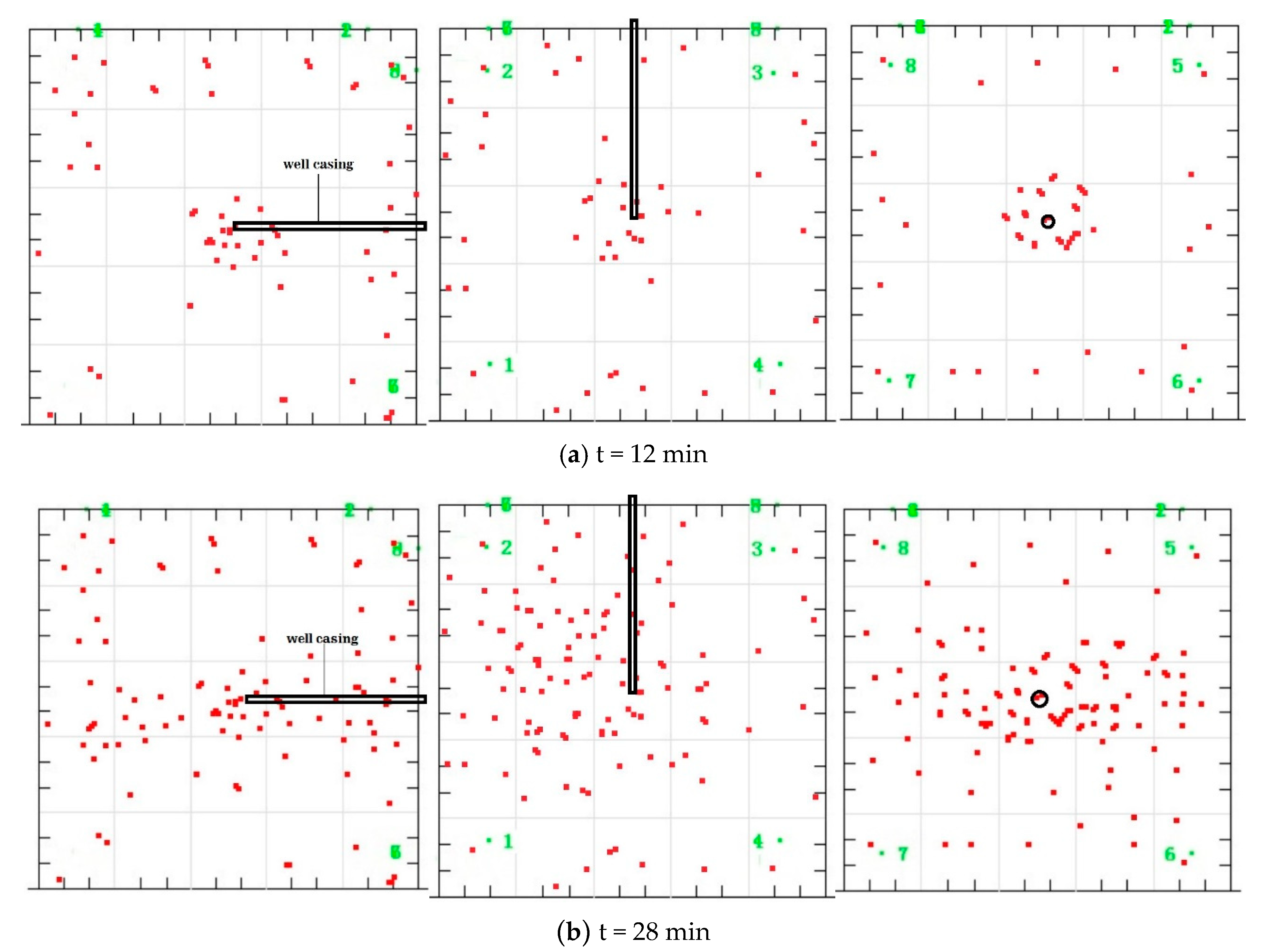


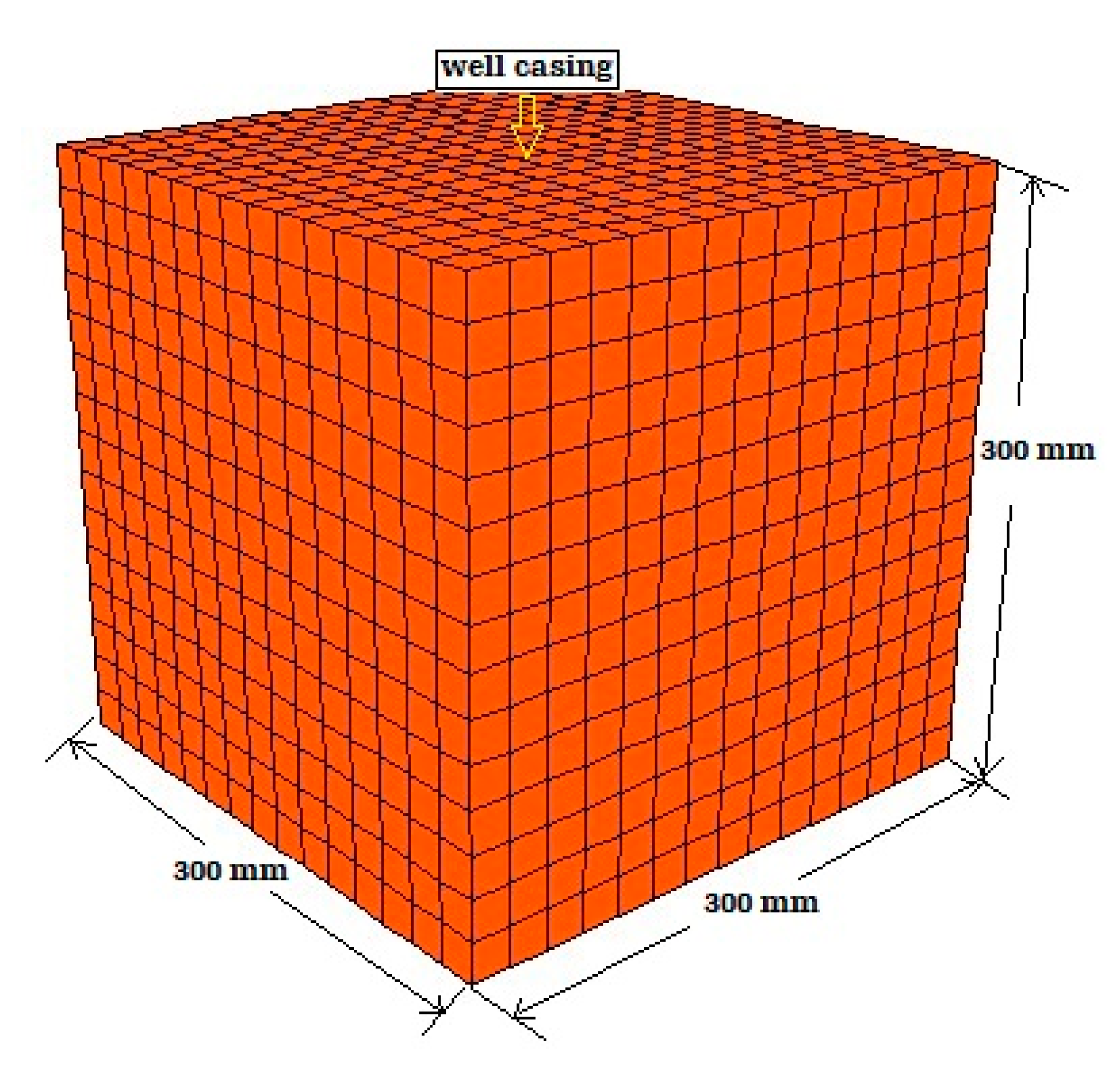
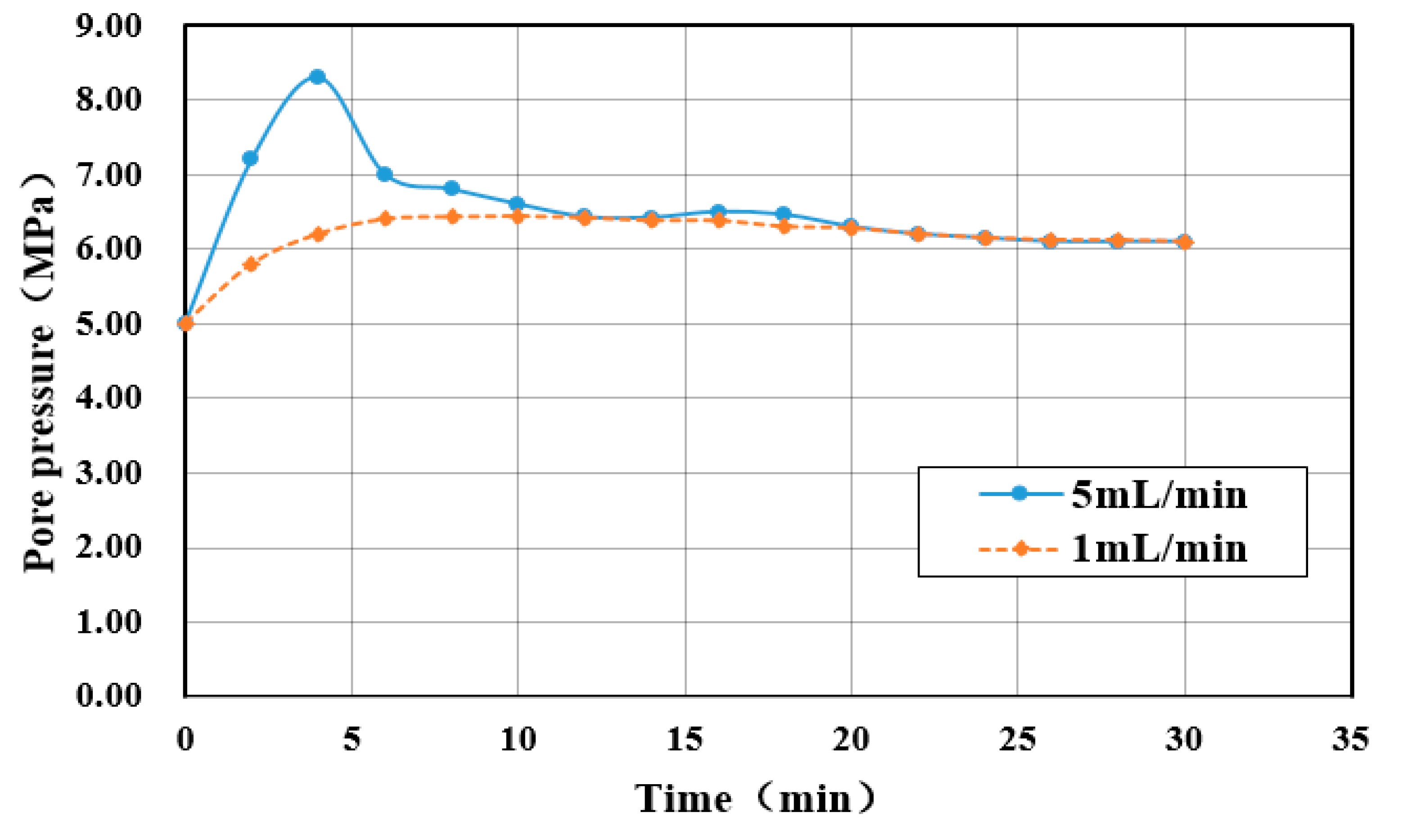

| The maximum fracturing pressure | 60 MPa |
| The maximum confining pressure | 32 MPa |
| Fracturing sample size | 300 mm × 300 mm × 300 mm |
| Operating temperature | <200 °C |
| The maximum pump pressure | 70 MPa |
| Rated load | 18 kw |
| Parameters | Group 1 | Group 2 | |
|---|---|---|---|
| H1 | H2 | F1 | |
| σy (MPa) | 10 | 10 | 10 |
| σz (MPa) | 8 | 8 | 8 |
| σx (MPa) | 6 | 6 | 6 |
| Injection water temperature (°C) | 10 | 0 | 10 |
| Sample temperature (°C) | 10 | 90 | 10 |
| Parameters | Value |
|---|---|
| σzz (MPa) | 10 |
| σxx (MPa) | 6 |
| σyy (MPa) | 8 |
| Density (kg/m3) | 2237 |
| Porosity (%) | 1.5 |
| Permeability (m2) | 5 × 10−17 |
| Elastic module (MPa) | 1300 |
| Passion’s ratio | 0.18 |
| Cohesion (MPa) | 15 |
| Internal friction angle (°) | 30 |
| KIC (MPa·m0.5) | 0.54 |
| Fluid viscosity (Pa·s) | 0.001 |
| Initial pore pressure (MPa) | 6 |
Publisher’s Note: MDPI stays neutral with regard to jurisdictional claims in published maps and institutional affiliations. |
© 2020 by the authors. Licensee MDPI, Basel, Switzerland. This article is an open access article distributed under the terms and conditions of the Creative Commons Attribution (CC BY) license (http://creativecommons.org/licenses/by/4.0/).
Share and Cite
Guo, L.; Wang, Z.; Zhang, Y.; Wang, Z.; Jiang, H. Experimental and Numerical Evaluation of Hydraulic Fracturing under High Temperature and Embedded Fractures in Large Concrete Samples. Water 2020, 12, 3171. https://doi.org/10.3390/w12113171
Guo L, Wang Z, Zhang Y, Wang Z, Jiang H. Experimental and Numerical Evaluation of Hydraulic Fracturing under High Temperature and Embedded Fractures in Large Concrete Samples. Water. 2020; 12(11):3171. https://doi.org/10.3390/w12113171
Chicago/Turabian StyleGuo, Liangliang, Zihong Wang, Yanjun Zhang, Zhichao Wang, and Haiyang Jiang. 2020. "Experimental and Numerical Evaluation of Hydraulic Fracturing under High Temperature and Embedded Fractures in Large Concrete Samples" Water 12, no. 11: 3171. https://doi.org/10.3390/w12113171
APA StyleGuo, L., Wang, Z., Zhang, Y., Wang, Z., & Jiang, H. (2020). Experimental and Numerical Evaluation of Hydraulic Fracturing under High Temperature and Embedded Fractures in Large Concrete Samples. Water, 12(11), 3171. https://doi.org/10.3390/w12113171




